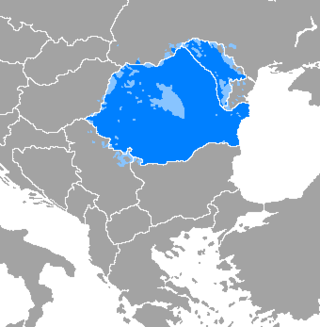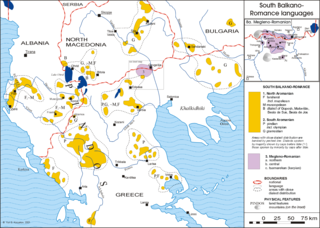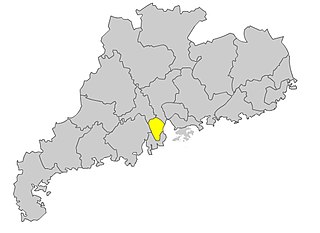
Romanian is the official and main language of Romania and Moldova. Romanian is part of the Eastern Romance sub-branch of Romance languages, a linguistic group that evolved from several dialects of Vulgar Latin which separated from the Western Romance languages in the course of the period from the 5th to the 8th centuries. To distinguish it within the Eastern Romance languages, in comparative linguistics it is called Daco-Romanian as opposed to its closest relatives, Aromanian, Megleno-Romanian, and Istro-Romanian. As a minority language it is spoken by stable communities in the countries surrounding Romania, and by the large Romanian diaspora. In total, it is spoken by 28–29 million people as an L1+L2 language, of whom c. 24 million are native speakers. In Europe, Romanian occupies the 10th position among 37 official languages.
The Istro-Romanian language is an Eastern Romance language, spoken in a few villages and hamlets in the peninsula of Istria in Croatia, as well as in the diaspora of this people. It is sometimes abbreviated to IR.
Several theories, in great extent mutually exclusive, address the issue of the origin of the Romanians. The Romanian language descends from the Vulgar Latin dialects spoken in the Roman provinces north of the "Jireček Line" in Late Antiquity. The theory of Daco-Roman continuity argues that the Romanians are mainly descended from the Daco-Romans, a people developing through the cohabitation of the native Dacians and the Roman colonists in the province of Dacia Traiana north of the river Danube. The competing immigrationist theory states that the Romanians' ethnogenesis commenced in the provinces south of the river with Romanized local populations spreading through mountain refuges, both south to Greece and north through the Carpathian Mountains. Other theories state that the Romanized local populations were present over a wide area on both sides of the Danube and the river itself did not constitute an obstacle to permanent exchanges in both directions; according to the "admigration" theory, migrations from the Balkan Peninsula to the lands north of the Danube contributed to the survival of the Romance-speaking population in these territories.
Common Romanian, also known as Ancient Romanian, or Proto-Romanian, is a comparatively reconstructed Romance language evolved from Vulgar Latin and considered to have been spoken by the ancestors of today's Romanians, Aromanians, Megleno-Romanians, Istro-Romanians and related Balkan Latin peoples (Vlachs) between the 6th or 7th century AD and the 10th or 11th centuries AD. The evidence for this can be found in the fact that Romanian, Aromanian, Megleno-Romanian, and Istro-Romanian share with each other their main language innovations comparative to Vulgar Latin on one hand, and distinctive from the other Romance languages on the other, according to Romanian linguist Marius Sala.

Megleno-Romanian is an Eastern Romance language, similar to Aromanian. It is spoken by the Megleno-Romanians in a few villages in the Moglena region that spans the border between the Greek region of Macedonia and North Macedonia. It is also spoken by emigrants from these villages and their descendants in Romania, in Turkey by a small Muslim group, and in Serbia. It is considered an endangered language.
There are several names of the Aromanians used throughout the Balkans, both autonyms and exonyms.

The Western Iranian languages or Western Iranic languages are a branch of the Iranian languages, attested from the time of Old Persian and Median.

Vivaro-Alpine is a variety of Occitan spoken in southeastern France and northwestern Italy. There is also a small Vivaro-Alpine enclave in the Guardia Piemontese, Calabria, where the language is known as gardiòl. It belongs to the Northern Occitan dialect bloc, along with Auvergnat and Limousin. The name “vivaro-alpine” was coined by Pierre Bec in the 1970s. The Vivaro-Alpine dialects are traditionally called "gavot" from the Maritime Alps to the Hautes-Alpes.
The history of the Romanian language started in Roman provinces north of the Jireček Line in Classical antiquity. There are three main hypotheses around its exact territory: the autochthony thesis, the discontinuation thesis, and the "as-well-as" thesis that supports the language development on both sides of the Danube. Between the 6th and 8th centuries AD, following the accumulated tendencies inherited from the vernacular Latin and, to a much smaller degree, the influences from an unidentified substratum, and in the context of a lessened power of the Roman central authority, the language evolved into Common Romanian. This proto-language then came into close contact with the Slavic languages and subsequently divided into Aromanian, Megleno-Romanian, Istro-Romanian, and Daco-Romanian. Because of limited attestations between the 6th and 16th centuries, entire stages from its history are reconstructed by researchers, often with proposed relative chronologies and loose limits.
The Aru languages are a group of a dozen Austronesian languages spoken on the Aru Islands in Indonesia. None are spoken by more than ten thousand people. Although geographically close to Central Maluku languages, they are not part of that group linguistically.

Sanxiang is a variety of Eastern Min or Southern Min Chinese mostly spoken in Sanxiang in Zhongshan in the Pearl River Delta of Guangdong, China. Despite its close proximity, Sanxiang is not very closely related to the surrounding dialects in the region, which belong to the Yue group, and thus forms a "dialect island" of Min speakers. It is one of three enclaves of Min in Zhongshan, the others being Longdu and Nanlang.

Western Romance languages are one of the two subdivisions of a proposed subdivision of the Romance languages based on the La Spezia–Rimini Line. They include the Gallo-Romance and Iberian Romance branches. Gallo-Italic may also be included. The subdivision is based mainly on the use of the "s" for pluralization, the weakening of some consonants and the pronunciation of “Soft C” as /t͡s/ rather than /t͡ʃ/ as in Italian and Romanian.
The Slavic influence on Romanian is noticeable on all linguistic levels: lexis, phonetics, morphology and syntax.

The Aromanian language, also known as Vlach or Macedo-Romanian, is an Eastern Romance language, similar to Megleno-Romanian, Istro-Romanian and Romanian, spoken in Southeastern Europe. Its speakers are called Aromanians or Vlachs. Some scholars, mostly Romanian ones, consider Aromanian a dialect of Romanian.
There have been a number of Arabic-based pidgins throughout history, including a number of new ones emerging today.

Theodor Capidan was an Ottoman-born Romanian linguist. An ethnic Aromanian from the Macedonia region, he studied at Leipzig before teaching school at Thessaloniki. Following the creation of Greater Romania at the end of World War I, Capidan followed his friend Sextil Pușcariu to the Transylvanian capital Cluj, where he spent nearly two decades, the most productive part of his career. He then taught in Bucharest for a further ten years and was marginalized late in life under the nascent communist regime. Capidan's major contributions involve studies of the Aromanians and the Megleno-Romanians, as well as their respective languages. His research extended to reciprocal influences between Romanian and the surrounding Slavic languages, the Eastern Romance substratum and the Balkan sprachbund, as well as toponymy. He made a significant contribution to projects for a Romanian-language dictionary and atlas.
Jatki, Jadgali, and other related terms have sometimes been used to refer to one or another of the Indo-Aryan languages spoken in Balochistan and neighbouring parts of Sindh and South Punjab.
The re-latinization of Romanian was the reinforcement of the Romance features of the Romanian language during the 18th and 19th centuries. In this period, Romanian adopted a Latin-based alphabet to replace the Cyrillic script and borrowed many words from French as well as from Latin and Italian, in order to acquire the lexical tools necessary for modernization. This process coined words for recently introduced objects or concepts (neologisms), added Latinate synonyms for some Slavic and other loanwords, and strengthened some Romance syntactic features.

The Albanian–Romanian linguistic relationship is a field of the research of the ethnogenesis of both peoples. The common phonological, morphological and syntactical features of the two languages have been studied for more than a century. Both languages are part of the Balkan sprachbund but there are certain elements shared only by Albanian and Romanian and its close relatives descended from Common Romanian. Aside from Latin, and from shared Greek, Slavic and Turkish elements, other characteristics and words are attributed to the Paleo-Balkan linguistic base: Illyrian, Thracian, Dacian and/or Thraco-Illyrian, Daco-Thracian. Similarities between Romanian and Albanian are not limited to their common Balkan features and the assumed substrate words: the two languages share calques and proverbs, and display analogous phonetic changes.








